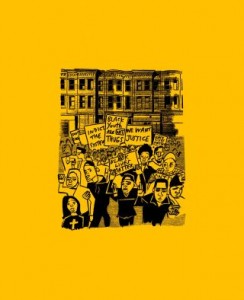Cobb, Jelani. “What Racism Has Done to Baltimore.” The New Yorker. The New Yorker, 11 May 2015. Web. 03 Aug. 2015.
This text is useful in relation to the Donald Trump tweet, because it helps others see what’s behind the Baltimore riots. It shows how the history of major issues, mainly aside from racism, could lead to this event happening. This article would be a good introduction and background information source in my paper and would highlight Trump’s flaws in credibility even more by showing how he lacks knowledge on the history leading up to the main issues of the Baltimore rioting. He only made racist remarks and failed to take into account the other issues within the city, tearing down his credibility.
As a New Yorker journalist, History Professor at The University of Connecticut, and author of “The Substance of Hope: Barack Obama and the Paradox of Progress.”, Jelani Cobb has successfully established himself as a reliable journalist in society. Regarding the Baltimore riots, he wrote the article “What Racism Has Done to Baltimore” in hopes of shedding light on the real issue at hand. “For a long time, our domestic affairs, or at least the portion of them most explicitly tied to race, have resembled a nightmare doomed to be repeated until the underlying conflict is resolved,” (Cobb 1). Background Information on Jelani Cobb can be found here. This article is credible, because the author has the knowledge and awards to write this article. He also illuminates Baltimore’s racist history and the real issues underlying the the riots in Baltimore.
Cobb starts off by mentioning a piece of Obama’s speech. He specifically calls out Obama’s statement, “This is not new,” because it shows how this crisis was always around and how we shouldn’t treat this as a new topic (Cobb 1). He also states that, aside from one, there are different instances in history in which riots against police tactics that have occurred within the African community. Cobb uses a statement from the police department to argue that the use of aggressive police tactics have become a main concern in Baltimore and society (Cobb 1). The author agreed with the mayor of Baltimore that the zero-tolerance policy has decreased the amount of crimes and homicides. That author has trouble with the amount of African American homicides occurring, because currently it is at a 189 out of 211 (Cobb 2). This highlights the real issue of “black-male-death” rates in that area, not “a homicide problem” (Cobb 2).
The author iterates that although race is an issue, regarding the Boston riots, that there are issues that extend beyond race. Sharing more historic information on Baltimore’s racism issue, Cobb uses the example of the first African American in 1910 to own his own property on a white block and how whites argued that would drive property values” down (Cobb 3). With this example, Cobb points out that the area of Baltimore started of majorly racist towards African Americans. As the city’s popularity decreases, the rate of African Americans grew within the city and shifted the area to being more crime-stricken and poor. Race isn’t a main issue, Cobb explains, but the area’s popularity worsening making the bad areas continue to stay that way and never progress.
The last thing Cobb points out is that there is a major issue with the securing of “poor, crime-prone communities” (Cobb 3). It’s not that African Americans don’t have an opportunity to impact their area through leadership positions in that area, it’s just that the cycle of bad communities in the city of Baltimore stays unchanged. He also compares Ferguson with Baltimore. Cobb brings up that Ferguson had more of a racist issue, not allowing blacks to progress in that area, whereas Baltimore has a cyclic issue of a poverty mentality.
This argument points out the history leading up to major issues associated with the Baltimore riots in early 2015 and hopes to get to the root of the problem beyond racism. The history of Baltimore explains how the city got to where it is now and in my paper would lead to the reason why Donald Trump would choose to tweet about the issues in Baltimore now.

